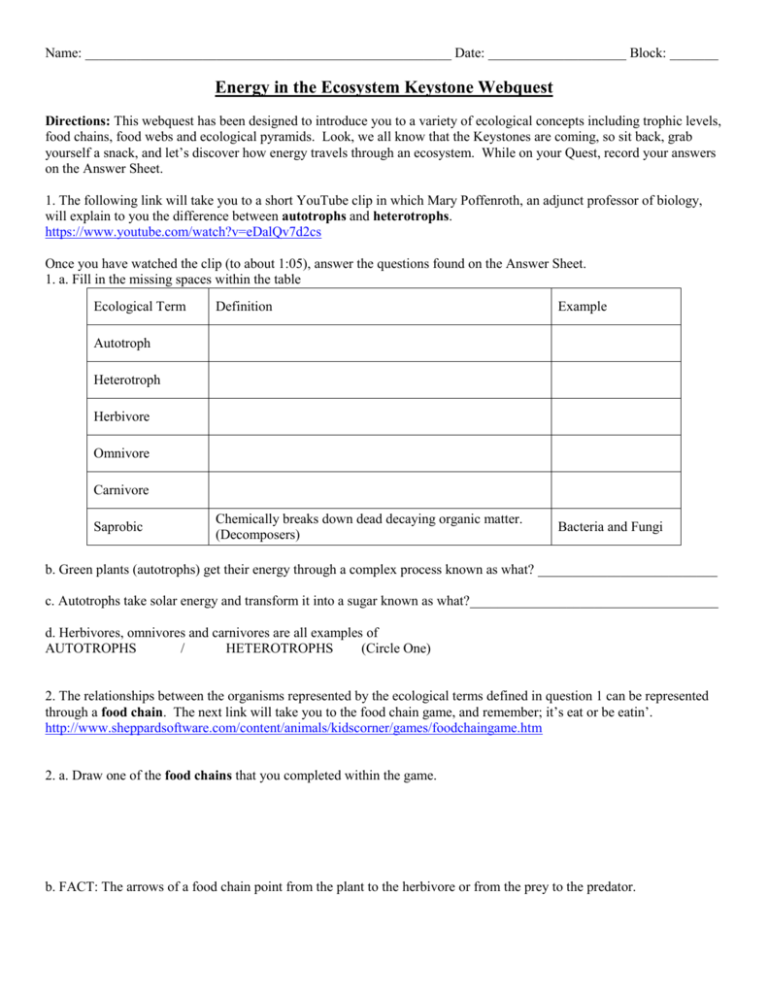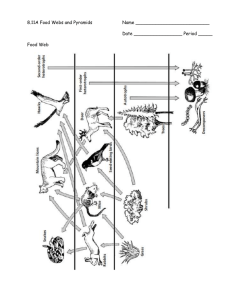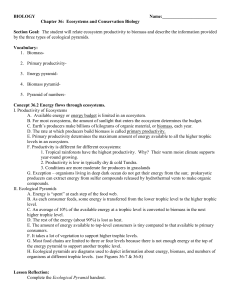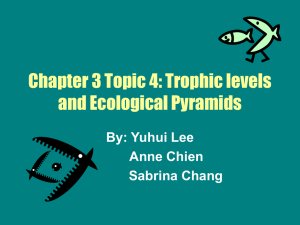Energy in the Ecosystem Keystone Webquest
advertisement

Name: _____________________________________________________ Date: ____________________ Block: _______ Energy in the Ecosystem Keystone Webquest Directions: This webquest has been designed to introduce you to a variety of ecological concepts including trophic levels, food chains, food webs and ecological pyramids. Look, we all know that the Keystones are coming, so sit back, grab yourself a snack, and let’s discover how energy travels through an ecosystem. While on your Quest, record your answers on the Answer Sheet. 1. The following link will take you to a short YouTube clip in which Mary Poffenroth, an adjunct professor of biology, will explain to you the difference between autotrophs and heterotrophs. https://www.youtube.com/watch?v=eDalQv7d2cs Once you have watched the clip (to about 1:05), answer the questions found on the Answer Sheet. 1. a. Fill in the missing spaces within the table Ecological Term Definition Example Chemically breaks down dead decaying organic matter. (Decomposers) Bacteria and Fungi Autotroph Heterotroph Herbivore Omnivore Carnivore Saprobic b. Green plants (autotrophs) get their energy through a complex process known as what? __________________________ c. Autotrophs take solar energy and transform it into a sugar known as what?____________________________________ d. Herbivores, omnivores and carnivores are all examples of AUTOTROPHS / HETEROTROPHS (Circle One) 2. The relationships between the organisms represented by the ecological terms defined in question 1 can be represented through a food chain. The next link will take you to the food chain game, and remember; it’s eat or be eatin’. http://www.sheppardsoftware.com/content/animals/kidscorner/games/foodchaingame.htm 2. a. Draw one of the food chains that you completed within the game. b. FACT: The arrows of a food chain point from the plant to the herbivore or from the prey to the predator. 3. The next link will take you to an interactive food web FLASH. A reminder for this interactive, the original arrows stemming from each organism mean “eats.” Drag the arrow to the organism that is being eaten, i.e. the mouse eats the plant. After you have correctly matched the organisms, the arrows will flip so that the correctly represent a food web. http://teacher.scholastic.com/activities/explorer/ecosystems/be_an_explorer/map/line_experiment14.swf 3. a. Print and attach your food web certificate. 4. Use the following link to answer the question, what is the difference between a food chain and a food web? http://www.sciencebob.com/questions/q-food_chain_web.php 4. a. What is the difference between a food chain and a food web? __________________________________________________________________________________________________ __________________________________________________________________________________________________ 5. Here she is again, Mary Poffenroth, an adjunct professor of biology, will now introduce our next concept. https://www.youtube.com/watch?v=qUZkWZ12A8s&list=PL16EB9E5F60FAD9BD&index=17 Once you have watched the clip (to about 1:51), answer the question below 5. a. What is meant by the term trophic structure? __________________________________________________________________________________________________ __________________________________________________________________________________________________ 6. Now that we have an understanding of food chains, food webs and trophic structures we can begin to discuss these concepts in terms of trophic levels. Use the following link to introduce yourself to the concept of trophic levels. http://www.allthingsnature.info/trophic-levels.html 6. a. Fill in the missing spaces within the table Trophic Level Definition Example (from a single food chain) Producer ( aka Primary Producers) Primary Consumer Secondary Consumer Tertiary Consumer Quaternary Consumer b. Critical Thinking: If an organism occupies the secondary consumer trophic level within a given food chain, is that organism always going to occupy the secondary consumer trophic level in other food chains. Provide an example in your response to support your thinking. __________________________________________________________________________________________________ __________________________________________________________________________________________________ 7. The ecological concept commonly referred to as the “Rule of 10” is in reference to how efficient energy is passed from one trophic level to the next. Visit the next resource to learn more about the “Rule of 10.” http://kids.britannica.com/comptons/art-90132/The-amount-of-energy-at-each-trophic-level-decreases-as 7. a. The “Rule of 10” states that as little as ________ % of the energy at any trophic level is transferred to the next trophic level. b. If I am a higher trophic level organism, this means that I need to eat MORE / LESS (circle one) food in order to fulfill my energy needs. c. The majority of the energy is lost as ________________ through the completion of metabolic processes. 8. Many of the concepts explored thus far can all be displayed utilizing an ecological pyramid. This next resource will provide insight into the different types of ecological pyramids. http://www.ecologyedu.com/education_resources/what_is_an_ecological_pyramid.html 8. a. Fill in the missing spaces within the table Ecological Pyramid Description Disadvantages of this type of Pyramid Pyramid of Numbers Pyramid of Biomass Pyramid of Energy b. What does the term biomass mean? ______________________________________________________________________________ c. Use the diagram below to answer the following questions. Which organism has more biomass, the Fox or the Rabbit? ________________ Which organism has more available energy, the Grass or the Fox? ________________ Which organism contains more individuals, the Zooplankton or the Phytoplankton? ________________









